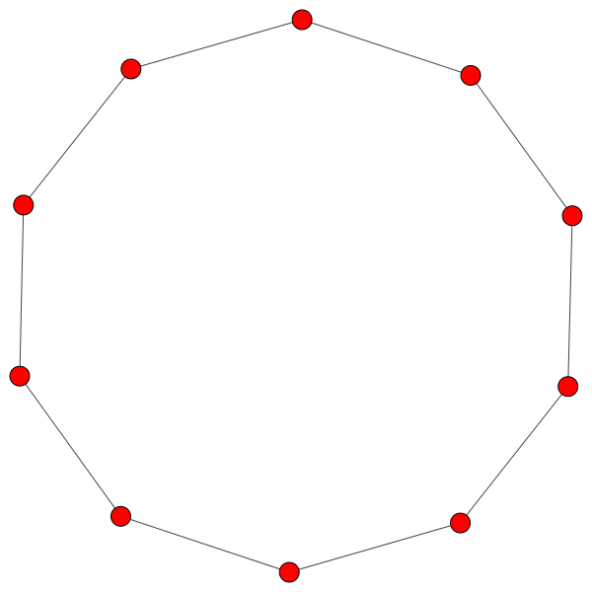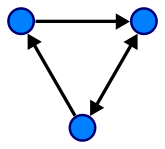Note: all definitions are assumed to be in the context of undirected graphs unless specified otherwise.
def
Graph: a diagram constituted by points (vertices) and some (possibly no) lines (edges) that connects some pairs of those points. It may be viewed as a visualization of the relationships between various components in a network.
def's
The number of vertices of a graph \(G\) is the order of \(G\), and the number of edges of \(G\) is the size of \(G\).

Note: A graph can be described as \(G=(V, E)\), where \(V\) is the set of vertices and \(E\) is the set of edges in \(G\).
The embedment below is interactive: left-click to create a vertex; drag from a vertex to another vertex to create an edge; right-click to delete.
def
The number of edges connected to a vertex \(v\) is the degree of \(v\), denoted as \(deg(v)\).
For example, every vertex of the graph in the image above has degree 4.
def
If a graph \(G\) has no loops (edges starting and ending at the same vertex) and no multiple edges between the same pair of points, then \(G\) is simple.
def
If a sequence of distinct edges \(e_1e_2...e_k\) is such that one can walk continuously through them, then it's a trail.
Note: an edge can also be expressed in terms of the vertices it connects (e.g \(v_1v_2\) is the edge that connects vertices \(v_1\) and \(v_2\)).
def
A walk is similar to a trail, except all edges walked through need not to be distinct.
The embedment below is interactive: click an edge to indicate a part of a trail. A green border indicates the most recent vertex passed by a walk. Note: this embedment doesn't allow repeated edges.
def
A trail that doesn't touch any vertex twice is a path.
def
A trail using all edges of \(G\) is an Eulerian trail of \(G\).
def
A trail that ends at the starting vertex is a closed trail.
def
A closed trail that doesn't touch any vertex twice is a cycle.
def
A cycle or path including all vertices of \(G\) is a Hamiltonian cycle or Hamiltonian path of \(G\).
def's
A graph with an empty edge set is an empty graph. A graph with an empty vertex set and an empty edge set is a null graph. A graph with a singleton vertex set and an empty edge set is a trivial graph.
def
If \(ab\) (\(a\), \(b\) are vertices) is an edge in a graph, then \(a\) and \(b\) are adjacent. Similarly, two edges are adjacent if they are incident on the same vertex.
def
Let \(G=(V(G), E(G)), H=(V(H), E(H)).\) If \(V(H) \subseteq V(G)\) and \(E(H) \subseteq E(G)\), then \(H\) is a subgraph of \(G\), or \(H \subseteq G\).

def's
\(H\) is
- a proper subgraph of \(G\) if \(V(H) \subset V(G)\) and/or \(E(H) \subset E(G)\)
- a spanning subgraph of \(G\) if \(V(H) = V(G)\) and \(E(H) \subseteq E(G)\)
- an (vertex) induced subgraph of \(G\) if \(H \subseteq G\) and for any pair of vertices \((x,y)\) of \(G\), if both \(x\) and \(y\) are in \(H\), then all of the edges connecting \(x\) and \(y\) in \(G\) are also in \(H\).
def's
If graph \(G\) is such that for any two vertices \(x\) and \(y\), one can find a path from \(x\) to \(y\), then \(G\) is connected. If \(G\) isn't connected, let \(k\) be the smallest integer so that \(G\) can be obtained as a union of \(k\) connected (sub)graphs. Then, \(G\) has \(k\) connected components.
def's
The distance between two vertices \(v_1, v_2\) in a graph is the length of the shortest path between them. This path is the geodesic between \(v_1\) and \(v_2\).
def
A path graph is a graph whose vertices can be listed in the order \(v_1, v_2,..., v_n\) such that all its edges are in the form \(v_iv_{i+1}\) where \(i=1,..., n-1\).
def
A cycle graph (or simply cycle) is a graph that consists of a single cycle. The length of a cycle graph is the number of its vertices or edges, and a cycle graph of length \(n\) is denoted as \(C_n\).

def
A complete graph is a simple undirected graph in which every distinct pair of vertices is connected by an edge. A complete graph on \(n\) vertices is denoted as \(K_n\).

def
The complement of a graph \(G\), denoted as \(\bar G\), is a graph that has the same vertex set as \(G\) and for all pairs of distinct vertices \(u\), \(v\) in \(G\), \(uv\) is an edge of \(\bar G\) if and only if \(uv\) is not an edge of \(G\).
def's
A graph \(G\) is regular if and only if each vertex has the same degree. A graph \(G\) is irregular if and only if all of its vertices have distinct degrees.
Question: Can a simple graph be irregular?
The animation below is interactive: left-click to create a vertex; drag from a vertex to another vertex to create an edge; right-click to delete.
def
The hypercube graph on \(n\) vertices (denotes as \(Q_n\)) is the graph formed by the vertices and edges of an \(n\)-dimensional hypercube. In particular, \(Q_n\) has \(2^n\) vertices and \(n2^{n-1}\) edges.

def
Let \(G\) be a graph on \(n\) vertices. Then, \(d_1d_2...d_n\) is a degree sequence of \(G\) if and only if the vertices of \(G\) can be labeled as \(v_1, v_2,..., v_n\) such that \(deg(v_i)=d_i\) for all \(i=1, 2,..., n\).
Conventionally, \(d_i \geq d_{i+1}\) for \(i=1, 2,..., n-1\).def
Graphs \(G\) and \(H\) are isomorphic if there is a one-to-one correspondence between the vertices of \(G\) and the vertices of \(H\) such that the number of edges between any pair of vertices in \(G\) is equal to that between their corresponding vertices in \(H\).
More formally, \(G\) and \(H\) are isomorphic if there is a bijection \(f \colon V(G) \longrightarrow V(H)\) such that the number of edges between any vertices \(X\) and \(Y\) in \(G\) is equal to that between \(f(X)\) and \(f(Y)\) in \(H\).
def
An automorphism of a graph \(G\) is an isomorphism between \(G\) and itself.
def
A graph in which each edge is assigned a direction is a directed graph or digraph.

def
A digraph \(G\) is strongly connected if for all vertices \(a\) and \(b\) in \(G\), there is a path from \(a\) to \(b\) and vice versa.
def's
The indegree of a vertex in a digraph is the number of edges ending in that vertex. The outdegree is the number of edges starting in that vertex.
def
A digraph is balanced if the indegree is equal to the outdegree for each vertex.
def
If each edge of a complete graph is assigned with a direction, the resulting digraph is called a tournament.
def
A tournament \(T\) is transitive if the fact that \(ij, jk \in E(T)\) implies \(ik \in E(T)\).

$$\text{Schur-Horn theorem}$$
$$\text{Let}$$ $$\{d_i\}, \{\lambda_i\}, i \in \{1,..., n\}$$ $$\text{be two sequences of reals, arranged in a non-increasing order.}$$ $$\text{Then, there is a Hermitian matrix with diagonal entries}$$ $$\{d_i\}$$ $$\text{and eigenvalues}$$ $$\{\lambda_i\}$$ $$\text{if and only if}$$ $$\sum_{i=1}^k d_i \leq \sum_{i=1}^k {\lambda_i}, \forall k \in \{1,..., n-1\}$$ $$\text{and}$$ $$\sum_{i=1}^n d_i = \sum_{i=1}^n {\lambda_i}.$$
Last updated: 7/11/2023